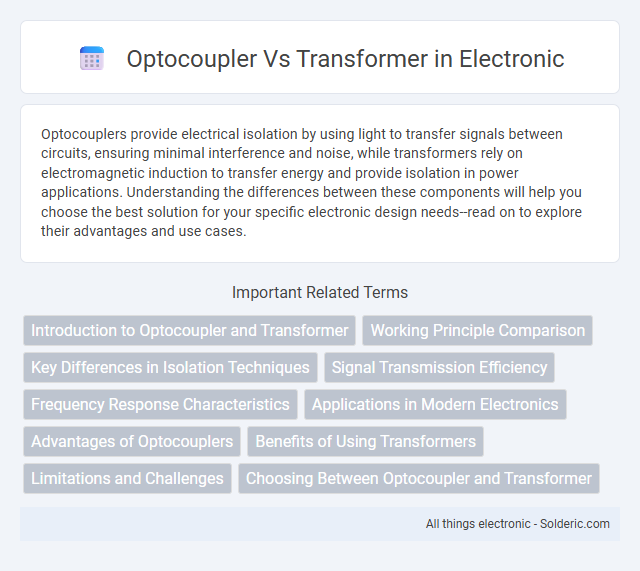Optocouplers provide electrical isolation by using light to transfer signals between circuits, ensuring minimal interference and noise, while transformers rely on electromagnetic induction to transfer energy and provide isolation in power applications. Understanding the differences between these components will help you choose the best solution for your specific electronic design needs--read on to explore their advantages and use cases.
Comparison Table
| Feature | Optocoupler | Transformer |
|---|---|---|
| Function | Electrical isolation and signal transfer using light | Electrical isolation and voltage/current transformation using magnetic induction |
| Isolation Method | Optical (LED and photodetector) | Magnetic core coupling |
| Frequency Range | Up to MHz range (low to moderate frequency) | Low to high frequencies (up to GHz in specialized types) |
| Size | Compact, small footprint | Generally larger, bulky |
| Power Handling | Low power signals only | High power voltage and current transfer |
| Applications | Signal isolation in digital and analog circuits, microcontroller interfaces | Power supplies, voltage conversion, impedance matching |
| Cost | Low to moderate | Moderate to high |
| Durability | Solid state, longer lifespan, no wear | Mechanical core can degrade, susceptible to vibration |
Introduction to Optocoupler and Transformer
Optocouplers transmit electrical signals using light to provide electrical isolation between input and output, making them ideal for noise reduction and signal integrity in sensitive circuits. Transformers transfer electrical energy between circuits through magnetic induction, enabling voltage conversion and galvanic isolation primarily in power applications. Both devices serve critical roles in isolation, but optocouplers excel in signal-level isolation while transformers handle power-level isolation.
Working Principle Comparison
Optocouplers isolate electrical signals using light transmission between an LED and a photodetector, enabling signal transfer without direct electrical connection, ideal for low-frequency or digital signals. Transformers operate on electromagnetic induction, transferring energy through coil windings and magnetic fields, making them suitable for AC power signals and voltage level adjustments. The key distinction lies in optocouplers providing galvanic isolation with signal integrity in data communication, while transformers excel in power conversion and isolation in high-voltage applications.
Key Differences in Isolation Techniques
Optocouplers provide electrical isolation using light transmission between an LED and a photodetector, ensuring galvanic separation with minimal electromagnetic interference. Transformers rely on magnetic induction through coils to transfer energy while isolating input and output circuits, suitable for AC signal and power applications. Your choice depends on required isolation voltage, frequency range, size constraints, and signal type.
Signal Transmission Efficiency
Optocouplers provide high signal transmission efficiency in low-frequency and digital applications by isolating input and output while minimizing noise interference. Transformers excel in power transfer and AC signal transmission, offering efficient energy transfer over a wide frequency range but with potential core losses at higher frequencies. Your choice depends on whether electrical isolation with low signal distortion or power handling efficiency is the priority in your application.
Frequency Response Characteristics
Optocouplers typically exhibit limited frequency response, often effective at frequencies up to a few hundred kilohertz due to the LED-phototransistor delay, while transformers provide superior bandwidth handling, easily operating from a few hertz to several megahertz. Your choice depends on the application's frequency requirements, with transformers preferred for high-frequency isolation and signal transfer. Optocouplers are suitable for lower-frequency or digital isolation tasks where electrical noise immunity is more critical than bandwidth.
Applications in Modern Electronics
Optocouplers provide electrical isolation and signal transmission in low-power circuits, commonly used in microcontroller interfaces, switching power supplies, and communication devices to protect sensitive components from voltage spikes. Transformers are essential in power electronics for voltage level conversion, AC signal coupling, and isolation in applications such as power distribution, audio equipment, and RF transmissions. Both devices ensure safety and signal integrity, with optocouplers favored for digital isolation and transformers preferred in high-power and AC applications.
Advantages of Optocouplers
Optocouplers provide superior electrical isolation by using light to transfer signals, eliminating direct electrical connections and reducing noise interference. Their compact size and low power consumption make them ideal for modern electronic circuits requiring efficient signal isolation within limited space. Unlike transformers, optocouplers can easily handle high-frequency signals and offer better compatibility with digital systems, enhancing overall performance and reliability.
Benefits of Using Transformers
Transformers provide superior electrical isolation and voltage transformation capabilities, making them ideal for power supply applications and signal coupling in high-voltage environments. They enable efficient energy transfer with minimal signal distortion and support wide frequency ranges, enhancing overall system reliability. Their robust design allows for handling large power loads, which optocouplers typically cannot manage.
Limitations and Challenges
Optocouplers face limitations in bandwidth and signal distortion, restricting their use in high-frequency applications and long-distance signal transmission. Transformers encounter challenges with size, weight, and core saturation, impacting efficiency and performance in low-frequency or DC isolation scenarios. Both devices require careful consideration of isolation voltage ratings and environmental conditions to ensure reliable operation.
Choosing Between Optocoupler and Transformer
Choosing between an optocoupler and a transformer depends on isolation needs, signal type, and frequency range. Optocouplers excel in low-voltage, low-frequency digital signal isolation with compact size and low power consumption. Transformers handle high-power AC signals and wide frequency ranges, providing galvanic isolation and voltage conversion in power applications.
Optocoupler vs Transformer Infographic

 solderic.com
solderic.com